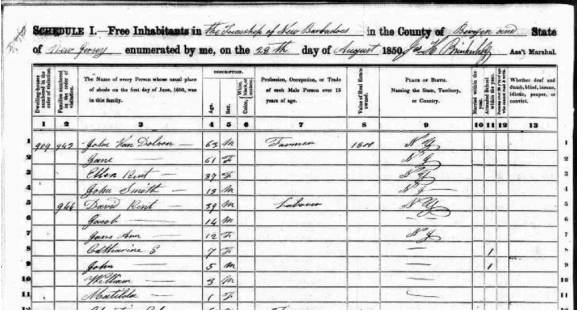What was Bergen County, New Jersey, like in 1850? Luckily, we can find many answers in the 1850 Federal Census. The 1850 Census is the Seventh U.S. Census, is notable for being the first to list every household member by name, including age, sex, color (white, black, or mulatto), profession, occupation or trade (for those over 15), value of real estate owned, and place of birth. It also asked if they were married within the year or attended school within the year. Also noted if they could not read or write (for people over 20) and if they had a physical or mental disability, or were a pauper or convict.
From the detailed report made of “The Seventh Census of the United States in New Jersey,” which breaks down the data for each county, we can tell a
lot about life in Bergen County one hundred and twenty-five years ago. For the full report, see :
https://www2.census.gov/library/publications/decennial/1850/1850a/1850a-23.pdf The population of New Jersey was 489, 313 divided among 20 counties [there are now 21]. Of the state’s population, 73% were born in NJ, 10% were born in another US state, 12% were foreign-born, and 5% unknown. Of the state’s population, 73% were born in NJ, 10% were born in another US state, 12% were foreign-born, and 5% unknown. There were 117 deaf people in New Jersey, 189 deaf and dumb, 207 blind, 379 insane and 419 idiotic. There had been a 32.4 % increase in population in the state from 1840 to 1850.
There were 14,725 persons living in Bergen County, including 13,060 whites, 1,624 free colored, and 41 slaves.In New Jersey in 1850, 382,120 people were born in New Jersey, 46,820 were born in another state, 59,948 were foreign born, and 431 had a place of birth that was unknown.
The residents of Bergen County were divided into eight townships: 3,506 were in Hackensack, 2,274 in Hohokus, 2,265 in New Barbadoes, 1,195 in Harrington, 1,807 in Washington, 1,741 in Franklin , 1,114 in Lodi, and 823 in Saddle River.
The census reported that among the 14,725 people in Bergen County in 1850, there were 303 births, 29 marriages, and 159 deaths (including one slave). There were 2,776 families living in 2,606 dwellings.
As returned by families, there were 1,879 white children and 63 free colored children attending school, 55 of whom were foreign-born. In the Education report for Bergen County; 2,730 students were attending 63 public schools taught by 64 teachers-[An average of over 42 students per teacher in these one-room schools.] There were no academies or colleges in Bergen County.
There were 21 churches in Bergen County;13 were Dutch Reformed, four were Methodist, one each for Baptists, Congregational, Lutheran, and Presbyterian, and no Roman Catholic churches.
The data for the “professions, occupations and trades of the male population, of NJ in 1850 reported on 128,540 men in over 250 occupations. The most reported were 36,300 laborers, 32,392 farmers,5, 540 cordwainers (shoemakers), 5,422 carpenters, 3,164 black and white smiths*, 2, 603 merchants, 2,106 clerks and 2,054 boatmen,
*Many of the laborers worked for farmers. **A white smith worked on tin and pewter, a black smith with iron and steel, often making horseshoes.
The 1850 Agricultural Schedule reported Bergen County had 80,494 acres of improved farm land and 34,585 acres of unimproved land, worth over six million dollars. Livestock included: 2,373 horses, 92 asses and mules, 3,398milch cows, 1088 working oxen, and 1,882 other cattle, 1,711 sheep and, 4,886 swine. The farms’ produce was very detailed as to the number of bushels of wheat pounds of butter etc. Among the crops raised and produced were: wheat, rye, Indian corn, oats, tobacco, wool, peas and beans, Irish potatoes, barley, buckwheat, wine, butter, cheese, hay, clover, other grasses, flax, flaxseed, maple syrup, beeswax, and honey.

